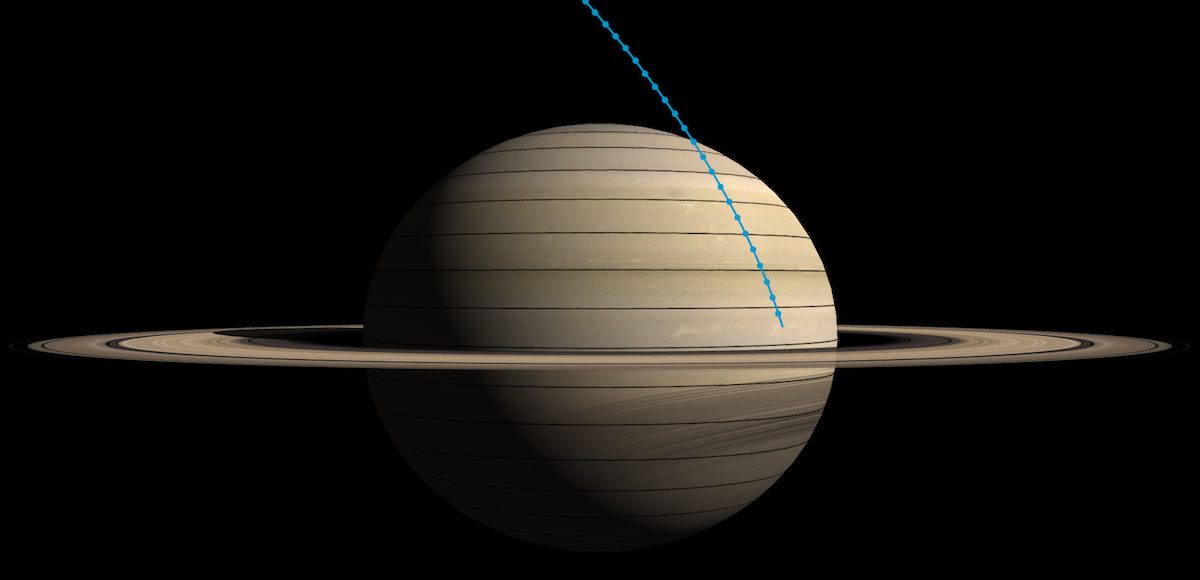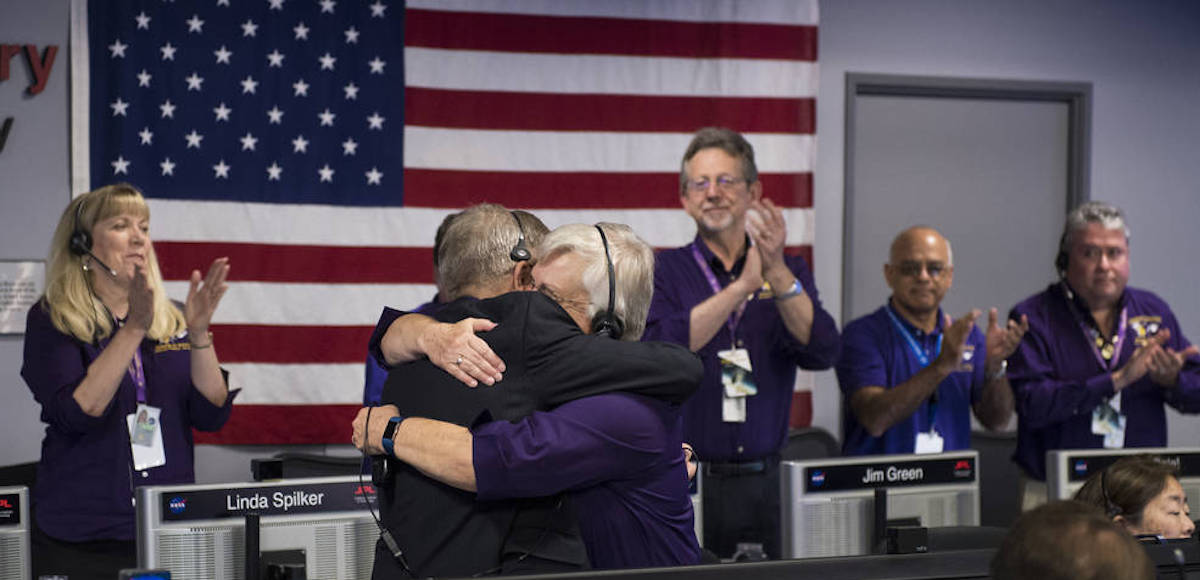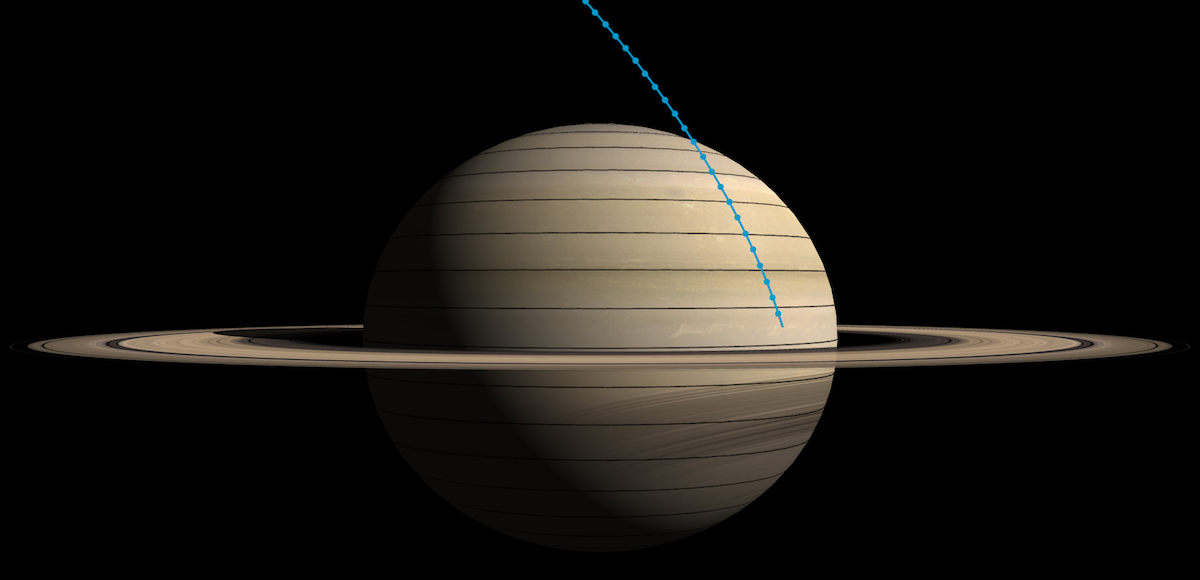

Cassini program manager at JPL, Earl Maize, left, and spacecraft operations team manager for the Cassini mission at Saturn, Julie Webster, right, embrace after the Cassini spacecraft plunged into Saturn, Friday, Sept. 15, 2017 at NASA’s Jet Propulsion Laboratory in Pasadena, California. Since its arrival in 2004, the Cassini-Huygens mission has been a discovery machine, revolutionizing our knowledge of the Saturn system and captivating us with data and images never before obtained with such detail and clarity. On Sept. 15, 2017, operators will deliberately plunge the spacecraft into Saturn, as Cassini gathered science until the end. The “plunge” ensures Saturn’s moons will remain pristine for future exploration. During Cassini’s final days, mission team members from all around the world gathered at NASA’s Jet Propulsion Laboratory, Pasadena, California, to celebrate the achievements of this historic mission. Photo Credit: (NASA/Joel Kowsky)
NASA’s Cassini spacecraft completed it’s historic mission on Friday by plunging into the atmosphere of Saturn, ending its 13-year tour of the ringed planet. Mission Control lost contact with the Cassini spacecraft took place on Sept. 15 at 7:55:46 a.m. EDT (4:55:46 a.m. PDT).
“This is the final chapter of an amazing mission, but it’s also a new beginning,” said Thomas Zurbuchen, associate administrator for NASA’s Science Mission Directorate at NASA Headquarters in Washington. “Cassini’s discovery of ocean worlds at Titan and Enceladus changed everything, shaking our views to the core about surprising places to search for potential life beyond Earth.”
Having expended almost all of the rocket propellant it carried to Saturn, NASA said Cassini was intentionally put on a path to plunge into the gas giant to ensure Saturn’s moons – in particular the ice-covered, ocean-bearing moon Enceladus, with its subsurface ocean and signs of hydrothermal activity – remained pristine for future exploration.

This graphic shows Cassini’s final plunge toward Saturn, with tick marks representing time intervals of 2 minutes, leading to the spacecraft’s entry into the atmosphere. (Photo: NASA/JPL-Caltech)
Enceladus is particularly interesting to NASA because — like Europa, the smallest of the four Galilean moons orbiting Jupiter — it conceals a global ocean of salty liquid water beneath its icy surface. Some of that water even shoots out into space, creating giant plumes.
Titan, a planet-sized moon Titan hiding dunes, mountains of water ice and rivers and seas of liquid methane, was also a factor in the plunge. Of the hundreds of moons in our solar system, Titan, with its intriguing pre-biotic chemistry, is the only one with a dense atmosphere and large liquid reservoirs on its surface.
That makes it in some ways more like a terrestrial planet.
“It’s a bittersweet, but fond, farewell to a mission that leaves behind an incredible wealth of discoveries that have changed our view of Saturn and our solar system, and will continue to shape future missions and research,” said Michael Watkins, director of NASA’s Jet Propulsion Laboratory (JPL) in Pasadena, California, which manages the Cassini mission for the agency. JPL also designed, developed and assembled the spacecraft.
The final plunge for Cassini closed out the “Grand Finale,” 22 weekly dives between Saturn and its rings, something never before accomplished or even attempted by any spacecraft.
“The Cassini operations team did an absolutely stellar job guiding the spacecraft to its noble end,” said Earl Maize, Cassini project manager at JPL. “From designing the trajectory seven years ago, to navigating through the 22 nail-biting plunges between Saturn and its rings, this is a crack shot group of scientists and engineers that scripted a fitting end to a great mission. What a way to go. Truly a blaze of glory.”
In 1997, NASA launched the Cassini spacecraft from Cape Canaveral Air Force Station in Florida. It finally arrived at Saturn in 2004 and NASA extended its mission twice — first for 2 years, and then again for 7 more. During the second mission, Cassini conducted dozens of flybys of the ringed planet’s icy moons. In 2009, its cameras captured images of Saturnian lighting for the first time.
“Things never will be quite the same for those of us on the Cassini team now that the spacecraft is no longer flying,” said Linda Spilker, Cassini project scientist at JPL. “But, we take comfort knowing that every time we look up at Saturn in the night sky, part of Cassini will be there, too.”
NASA said the enormous amount of data the Cassini spacecraft collected on its mission to Saturn — including its magnetosphere, rings and moons — will continue to yield new discoveries for decades to come.
“Cassini may be gone, but its scientific bounty will keep us occupied for many years,” Spilker said. “We’ve only scratched the surface of what we can learn from the mountain of data it has sent back over its lifetime.”








Phyllip Boguslawski / September 15, 2017
soon saturn will retaliate for our unprovoked attack !!!
/
Richard D. Baris / September 20, 2017
Excellent comment! We literally LOL.
/